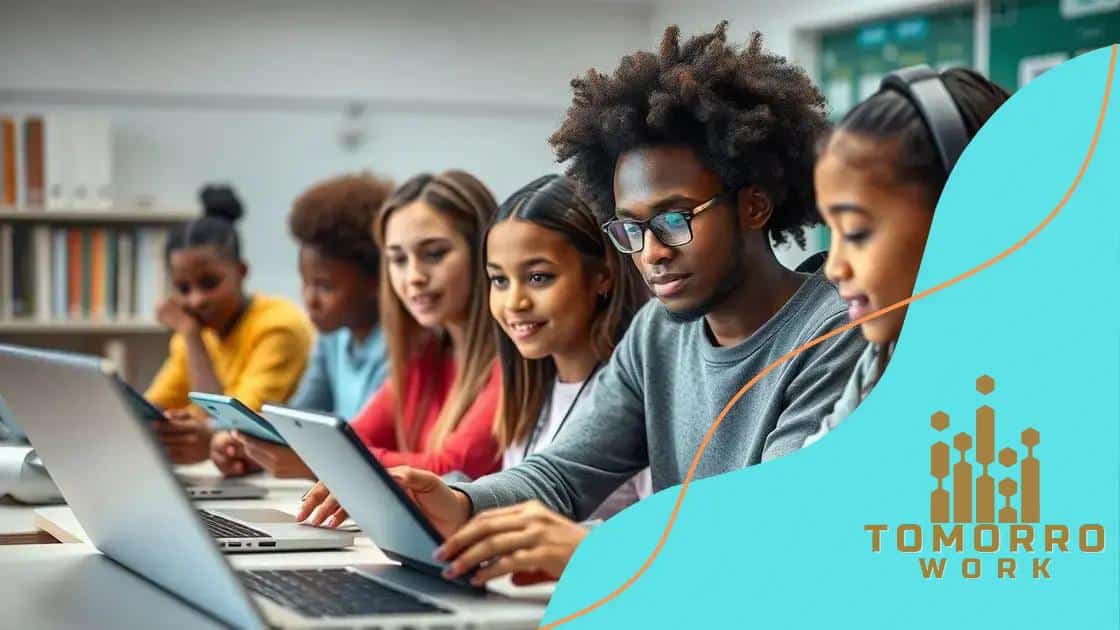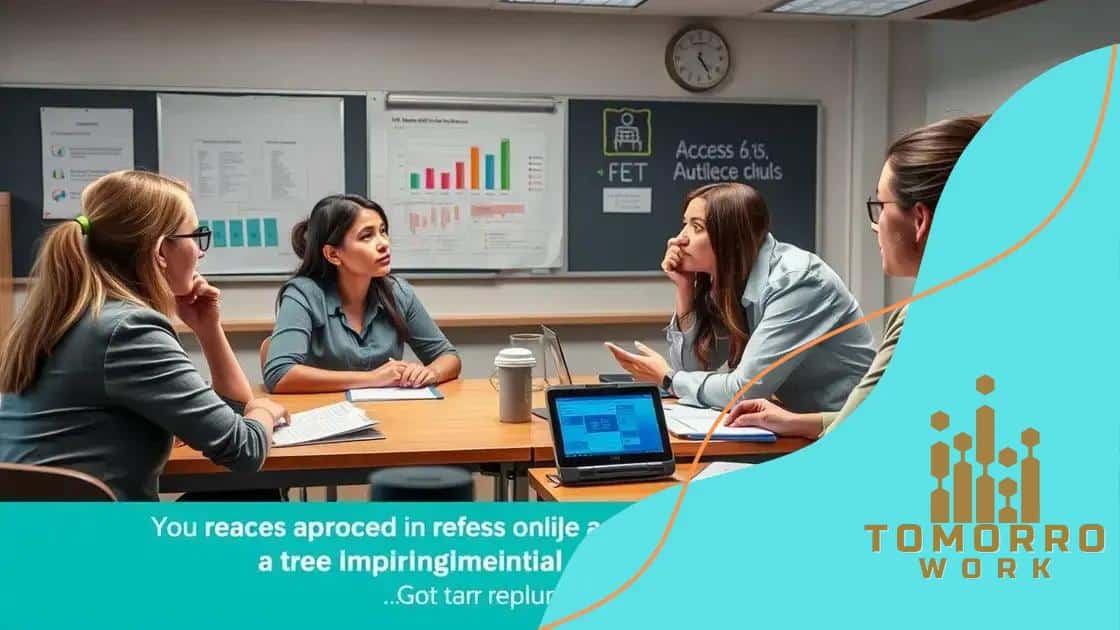How AI-powered tutoring systems are improving education accessibility

Advertisements
AI-powered tutoring systems enhance education accessibility by providing personalized learning experiences, immediate feedback, and adapting to individual student needs, thereby transforming traditional educational methods.
How AI-powered tutoring systems are improving education accessibility is an exciting development in the world of learning. Imagine a classroom where every student receives the support they need at their own pace. Curious about how this is changing the educational landscape? Let’s explore!
Advertisements
Understanding AI-powered tutoring systems
Understanding AI-powered tutoring systems is essential in today’s educational landscape. These systems use advanced technologies to customize learning experiences for students. Instead of a one-size-fits-all approach, AI tools adapt to each learner’s needs, making education more effective.
How AI Works in Tutoring
AI tutoring systems analyze student behavior and performance. They gather data about what works for each student and what doesn’t. This allows them to create personalized learning plans. For example, if a student struggles with math, the AI will offer extra exercises in that area.
Benefits of AI-powered Tutoring
- Personalized learning experiences
- Immediate feedback and support
- Accessibility for students with disabilities
- 24/7 availability for learning
Moreover, AI tutoring provides instant feedback. When a student answers a question, the system evaluates their response and gives tips on how to improve. This immediate support helps students learn faster and retain information better.
Advertisements
Another significant advantage is accessibility. With AI-powered tutoring, students can learn at their own pace, which is especially beneficial for those who may need extra time to grasp concepts. These tools also often accommodate different learning styles, ensuring everyone can benefit.
Challenges of AI Tutoring
However, it’s important to recognize the challenges. Not all students have access to technology. There may be disparities in resources, which can affect who benefits from these systems. It’s crucial to ensure that AI-powered tutoring is accessible to all learners.
In summary, understanding AI-powered tutoring systems reveals how they are transforming education. They offer unique benefits, but challenges remain. As technology continues to evolve, so will these systems, making learning more effective for everyone.
Benefits of AI in education
The benefits of AI in education are transforming the way students learn. These technologies provide tools that adapt to each student’s unique needs. As a result, educators can offer personalized learning experiences that motivate and engage.
Key Advantages of AI
One significant advantage is the ability to provide immediate feedback. When a student answers a question, AI systems analyze the response right away and offer suggestions for improvement. This instant support helps students understand concepts better and encourages them to keep trying.
Enhanced Learning Paths
- Adaptable learning materials based on student performance
- Accessible resources for students with learning disabilities
- Tailored tutoring sessions for different learning styles
- 24/7 accessibility for studying outside traditional hours
Moreover, AI in education makes learning accessible to everyone. With tools that cater to various learning abilities, students with disabilities can thrive. For instance, text-to-speech technology assists students who have trouble reading by converting written information into audio.
Another remarkable benefit is the efficiency of administrative tasks. Teachers can spend less time grading and managing paperwork. Instead, they can focus more on teaching. This shift allows educators to dedicate more attention to their students, enhancing overall educational quality.
Data-Driven Insights
AI also provides valuable data-driven insights. Teachers can analyze trends in student performance over time. This information helps identify students who may need extra assistance. As a result, educators can intervene early and provide needed support.
In summary, the advantages offered by AI in education are numerous. They not only improve student learning outcomes but also streamline teaching processes. As these technologies develop, we can expect even greater enhancements in the educational experience.
Challenges faced in implementing AI tutoring

The challenges faced in implementing AI tutoring are significant yet critical to address. Adopting this technology can transform educational experiences, but several hurdles can hold back its success.
Access to Technology
One major issue is access to technology. Not every student has the necessary devices or reliable internet connections. This disparity can create gaps in who is able to benefit from AI-powered tutoring. Ensuring that all students have equal access to tools is vital for widespread adoption.
Data Privacy Concerns
- Concerns about data collection and use
- Regulations on student information privacy
- Parental consent and involvement
Another significant challenge is data privacy. Schools must be careful about collecting and storing information about students. Parents often worry about how their children’s data is used. Therefore, strict measures should be in place to protect this information while ensuring transparency about its use in AI systems.
Furthermore, implementing AI tutoring systems requires training for teachers. Educators need to understand how to integrate these systems effectively into their lessons. Without proper training, even the best technology can fall short. Teachers may feel overwhelmed and unsure of how to use AI tools to enhance learning.
Cost of Implementation
Cost is another barrier. Schools face significant expenses when adopting new technologies. Not only does this include purchasing devices, but it also covers software and ongoing maintenance costs. Budget limitations can hinder schools from fully embracing AI systems.
Finally, skepticism about AI in education can be a significant obstacle. Some educators and parents might doubt the effectiveness of AI. They may worry that machines cannot replace human interaction in teaching. It’s vital to build trust in these systems by showcasing their successes and effectiveness in real-world applications.
Real-world examples of AI tutoring
Exploring real-world examples of AI tutoring provides insight into how these systems are making a difference in education. Different technologies are being used in various settings, showing promising results.
Adaptive Learning Platforms
One notable example is the use of adaptive learning platforms. These systems assess a student’s current knowledge and adapt lessons accordingly. Programs like Khan Academy and Smart Sparrow allow students to learn at their own pace while receiving immediate feedback on their progress.
AI in Math Tutoring
- DreamBox Learning: This platform offers individualized math instruction for students in grades K-8. It adapts in real-time, tailoring problem sets to student abilities.
- Carnegie Learning: This program combines technology and teacher involvement. It provides personalized pathways for students, ensuring they grasp foundational concepts before moving on.
- Mathway: An AI-powered platform that helps students tackle math problems step-by-step, getting instant assistance when needed.
Additionally, AI tutoring extends beyond mathematics. For instance, language-learning apps like DuoLingo allow users to practice languages with personalized lessons. The AI analyzes progress and adapts the difficulty of tasks, making learning engaging and effective.
Furthermore, AI tutoring can also cater to special needs. Programs like Zaption use video interactions to teach subjects in a way that meets the varying needs of all students. This approach ensures that learning remains inclusive and impactful.
Success Stories in Schools
In schools, districts using AI tutoring have reported significant improvements in student performance. For example, a pilot program implementing AI-driven tools in classrooms showed a 20% increase in test scores. Teachers noted that these systems provided insights that allowed them to focus on students who needed extra help.
Overall, these real-world examples of AI tutoring illustrate its potential to enhance education. By personalizing learning experiences and providing support tailored to individual needs, AI can help students succeed in ways that traditional methods might not achieve.
The future of education with AI tutoring
The future of education with AI tutoring looks bright and full of promise. As technology advances, these systems are set to become more integrated into the classroom experience, enhancing how students learn and teachers instruct.
Personalized Learning Experiences
One of the exciting possibilities is truly personalized learning. Future AI systems will analyze vast amounts of data to understand each student’s strengths, weaknesses, and preferences. This allows for tailored educational experiences that resonate with individual learning styles.
Integration of Virtual Reality
- Virtual classrooms: AI may help create immersive virtual learning environments where students can interact with 3D simulations.
- Interactive lessons: Students can engage in real-time scenarios that relate to their course materials.
- Global reach: Learners from different parts of the world can collaborate and communicate through shared virtual spaces.
Incorporating virtual reality into AI tutoring creates engaging scenarios that make learning fun and effective. Imagine students exploring the solar system or walking through historical events, all while learning core subjects.
Moreover, AI systems are expected to evolve alongside educational curricula. They will regularly update based on the latest teaching methods and educational standards. This adaptability ensures that students are equipped with the most relevant knowledge and skills as they prepare for future job markets.
Collaborative Learning
Another aspect of the future is the promotion of collaborative learning through AI. These tools can analyze group dynamics and suggest optimal group formations. By understanding how students work together, AI can foster an environment that encourages teamwork and collaboration.
As AI tutoring becomes more commonplace, the role of teachers will also evolve. Educators will shift from traditional instruction to more facilitative roles, guiding students through their learning journeys. Teachers will use AI tools to gain insights into student progress and focus their efforts where needed the most.
The potential for integrating artificial intelligence into education is vast. As AI tutoring continues to advance, we can expect innovative solutions that meet the diverse needs of all learners. This revolution could lead to a more effective, engaging, and inclusive educational landscape.
FAQ – Frequently Asked Questions about AI-Powered Tutoring
How does AI tutoring personalize learning for students?
AI tutoring systems assess each student’s strengths and weaknesses to create customized learning experiences tailored to their individual needs.
What are the main benefits of using AI in education?
The main benefits include enhanced personalization, immediate feedback, increased engagement, and improved accessibility for all learners.
What challenges do schools face when implementing AI tutoring systems?
Schools often encounter challenges such as access to technology, data privacy concerns, cost of implementation, and the need for teacher training.
How will AI tutoring shape the future of education?
AI tutoring is expected to provide more interactive learning experiences, empower teachers, and facilitate collaboration among students, making education more efficient and inclusive.





